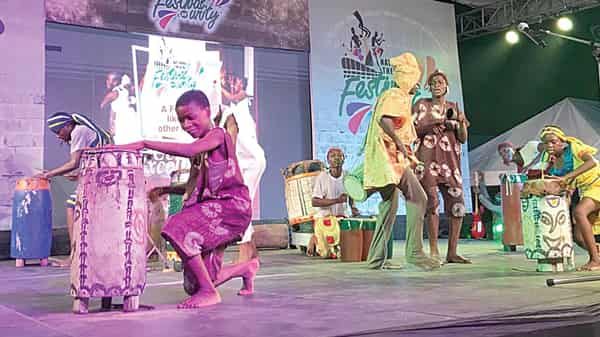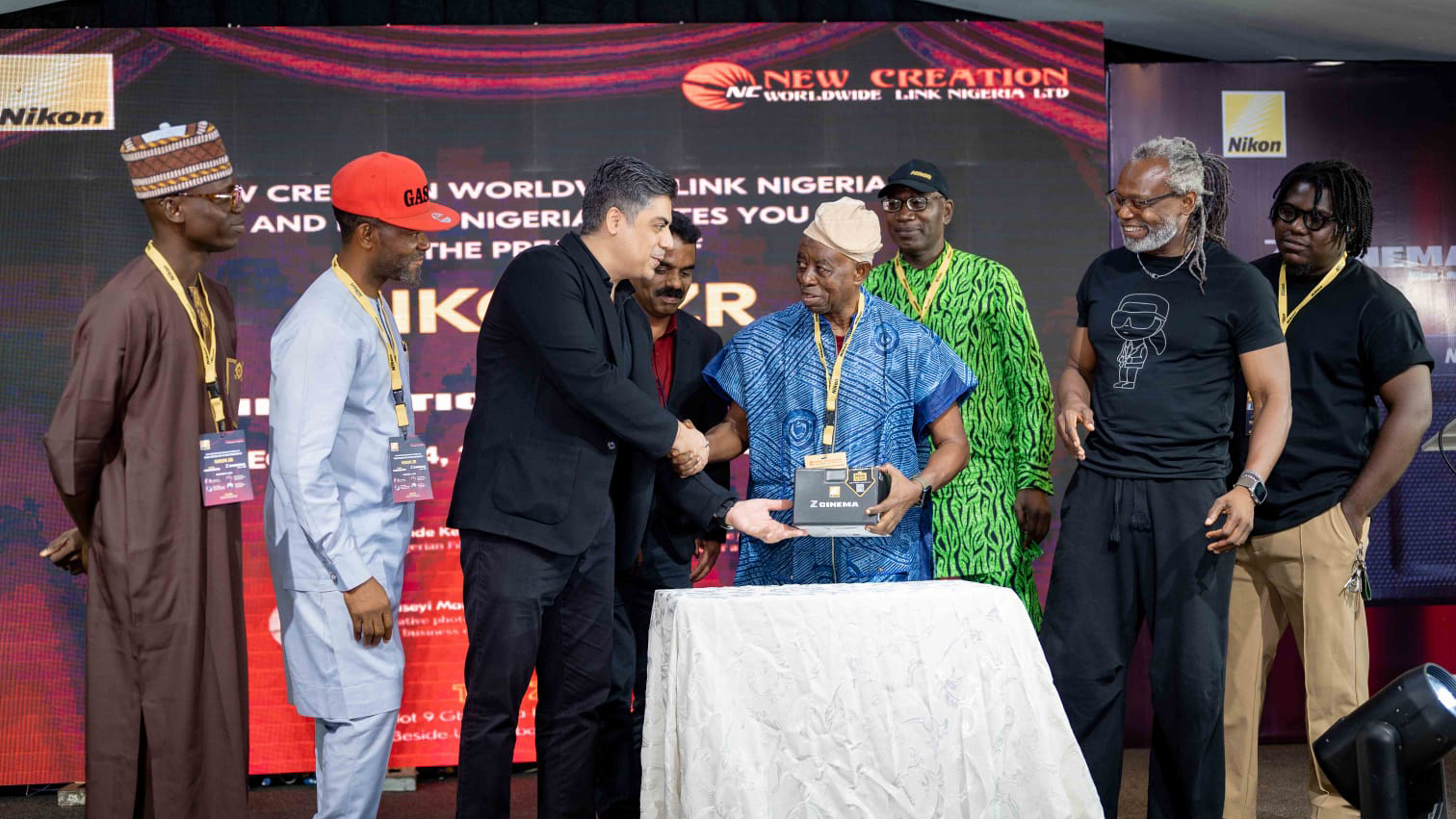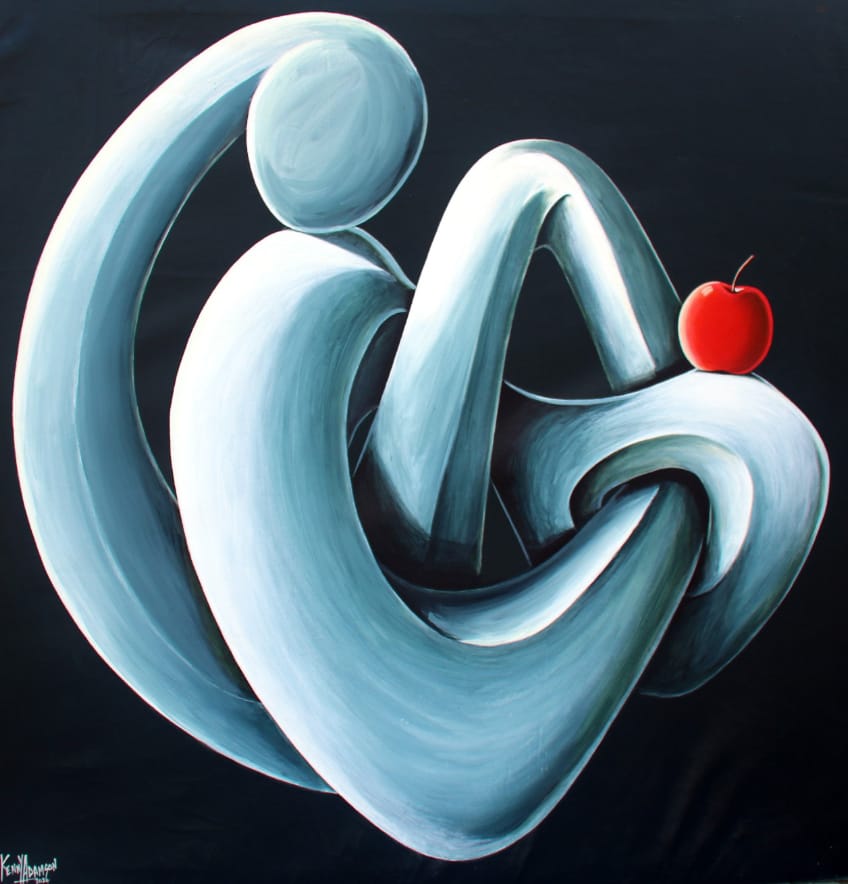
The moment he stepped on stage, it was very hard not to notice the rhythm and flow. The dance movement seemed like his body was responding to a new canon: The knees, elbows, legs, arms and head traveled across the scenic space. He communicated with them, bringing something real and meaningful. The dance piece served up as a three-course meal, falling roughly into appetizer, main course and dessert.
The artiste was Adedayo Liadi. He became famous with his masterful dance rendition of Infinity’s Olori Oko. The dance was the kind that took the breath away – and revealing superb craft.
But Liadi’s ascension to fame actually began with fifth edition of the African and Indian Ocean Choreography Platform, Sanga 3, which he won in 2003. And no thanks to the first attempt at ‘foreignisation’ of Nigerian dance form.
In 1994, the French Cultural Centre, Lagos, organised a workshop on dance, where Claude Brumachon and Benjamin Larmache were invited to teach Nigerian choreographers and dancers, Europe’s dance concept called Contemporary Dance.
The workshop had over three hundred dancers in attendance, but only seven were selected to participate in the artist-in-residence programme at the Centre Choreographique National de Nantes, France, in 1995.
The seven successful dancers were Abel Utuedor, Faith Benson, Abubakar Usman, Esther Olaniyan (now Esther Abubakar Usman), Adebayo Liadi, Bayo Ogunrinade and Christopher Abdul Onibasa (now Christopher Emmanuel Onibasa). These dancers went on tour of West Africa and France in 1996 with a dance piece choreographed by Brumachon titled, When The Gods Go Crying.
During the years between the first contemporary dance workshop and the birth of the first festival in the country —Danse Meets Dance (DMD) Festival —the genre has grown much bigger and more complicated than the origin would have suggested.
DMD, which started in 2001, was first organised and run by the French Cultural Centre Lagos, until 2004, when the centre closed in the country before it was reopened 2018 by the country’s president, Macron, when he visited Nigeria.
At the time, it seemed idiosyncratic, to say the least, for Nigerians to embrace such a dance concept with no correlation with traditional movement. Less than three decades after, the landscape has been transformed in the country.
Compared to its more illustrious ‘younger cousin’, contemporary dance, traditional dance in Nigeria is no longer as important as it once was. A gradual decline since the era of colonisation and less encouraging state policy towards the creative arts have reduced the genre to ‘tokenism’.
This erosion of traditional dance values makes the former national choreographer and theatre teacher in Calabar, Dr. Arnold Udoka, sad.
To him, “you have to sit back and ask how long has this been going on? How long has this genre been displaced by economic dictates?”
Udoka, who has created over 70 works, some of which include, Ndem Mmong; The Defilement; New Generation; Ariagha-Umo-Nkoriko; We, The Dead; Song of the Sea, Abaikpa Ideghe Akang Iba, Fire of Peace; New Frontiers; Flames of the Niger; The Water Basket; One Earth, One People; Rites (Rights) of Passage. Damsel; Dawn; noted that dance forms in the country have changed, which makes it difficult to know how they were performed at that time.
Liadi, a graduate of Senegal International Centre for Dance and Choreography, however, does not believe that traditional dances are fading away.
He noted that traditional dances are in major demand, but some artistes, who do not know what they are doing want to be classified as practitioners of the contemporary genre. “They are shying away from their cultural heritage to emulate Western culture. I’m doing Nigerian dances as well, but my contemporary dance has Nigerian flavour,” he said. “I use traditional dance and music as source of imagination or as a glossary of composition. The choreography leaves its root and returns to them just as it feeds on a variety of influences and styles without ever letting itself be misled. It draws from these languages to create something decidedly unique.”
Africa2020 Season
Next year, Africa’s art and culture will go under another French knife, as the country prepares to host Africa2020, which was earlier scheduled to hold from December to June 2021.
Initiated by French President, Emmanuel Macron, around the major challenges of the 21st century, the Africa2020 Season is dedicated to the 54 countries of the continent.
During a speech he gave in Ouagadougou on November 28, 2017, President Macron had announced that the aim is to help French people learn more about contemporary Africa and its creativity through a series of events focusing on young people and emerging talents.
Organised and implemented by the Institut Français, the Africa2020 Season brings together several events throughout France next year.
He also said that the festival would provide opportunity to launch structural partnerships in all creative fields, encourage cultural entrepreneurship and showcase African expertise.
In the words of N’Goné Fall, General Commissioner of the Season, “Africa2020 is an invitation to look at and understand the world from an African perspective.”
Many see this project by France as evidence of the country’s ways of foisting new ideas on Africa. The art of using culture, as a diplomatic tool was a French invention in the late 19th century. Following its defeat in the Franco-Prussian war, 1870-1871, the French government sought to repair the nation’s shattered prestige by promoting its language and literature through L’Alliance Francaise created in 1883.
The projection of French culture abroad, thus, became a significant component of French diplomacy. Other countries such as, Italy, Germany, Britain and the United States followed suit.
Africa ‘95 Festival
In 1995, Africa was also under spotlight across the UK with numerous performances, exhibitions, concerts, readings, film showings, lectures and conferences presented throughout the year as part of Africa ‘95 Festival. The event brought together, for the first time, an impressive range of visual artists, writers, playwrights, filmmakers, musicians and academics from Africa and the Africa Diaspora.
Over the past three decades, foreign involvement in Nigerian art and culture has boomed. Nigeria currently hosts so many foreign agencies, whose mission is to promote their language and protect their culture, which many of these agencies engage in.
Their main vehicles are exhibitions in the visual, literary and performing arts, interpersonal communication achieved through exchanges of artists, journalists, writings, film makers, cultural workers, teachers and instructors or through lectures, symposia, seminars conferences, competitions and accession to treaties designed to promote mutual interests and improve understanding.
Thousands of artists and intelligentsia have left the country since their encounter with culture missioners from the Western world.
While these foreign agencies are aggressively promoting their various cultures and languages, and getting Nigeria’s young ones immersed in them, the country is tragically indifferent to the promotion of its own.
Every February, Lagos is often agog with theatrical feast, tagged Lagos Theatre Festival. Now in its seventh edition, the festival features a wide variety of artistic expressions such as, drama, dance, comedy, spoken words, concerts, film, and others in unconventional spaces and traditional theatres.
The festival was conceived and launched in 2013 with four shows as a fringe festival by the United Kingdom’s cultural organisation, British Council, in response to the inspiration to provide a platform for theatre makers in Nigeria, to develop audiences for theatre productions and to produce theatre works for unconventional spaces.
Between 2013 and 2019, there have been seven editions of LTF, over 420 shows, with over 42,800 overall attendance, 50 workshops, 260 production companies, with 15 countries in participation.
Already, K-Pop dance, a new performative idiom, has become a phenomenon that Korean cultural centres around the world host courses on.
There is a dance contest organised yearly by Korean Cultural Centre of the Embassy of the Republic of Korea in Nigeria that aimed at promoting understanding and strengthening bilateral relationship between Nigeria and Korea through cultural exchange programmes and activities.
Once, a team from Nigeria conquered the K-pop world and became the first team from African continent to win the KBS World K-pop competition.
With Nigeria’s economy in poor shape, admission of Nigeria’s youngsters into the foreign language programmes of the different culture missions has been on the rise, with their possible intent of ‘checking out’ of the country for greener pastures abroad, with the facility and mastery of these foreign languages.
Every month, one artist or the other escapes to Europe or America, fleeing from grinding poverty and in search of greener pastures.
From London to Paris, New York to Berlin, Nigeria has one of the highest numbers of ‘artistes in exile’. In every corner of the world, you’re likely to see a Nigerian actor, writer, musician, dancer/choreographer, painter, sculptor, photographer, arts historian, curator, critic or academic hustling. Increasingly, they are escaping to more vulnerable status.
A major element of these agencies is what some critics have termed the continuing colonialisation of Africa, especially in the culture-defining area of language acquisition, where European languages dominate the cultural calendar of these agencies.
And so from Britain’s British Council to Germany’s Goethe-Institut Nigeria to France’s Alliance Francaise and China’s Confucius Institute, their language curriculum is probably the biggest programme on offer.
Recently, the Confucius Institute project of China has joined. It has, in fact, gathered an impressive momentum since 2004 more than 400 Confucius Institutes (and 600 smaller Confucius Classrooms) have been set up in 120 countries and regions.
The institutes are focused on providing an understanding of China that is primarily based on language learning as the route towards greater comprehensibility and accessibility and although their presence has helped to present a view of China that is fuller than any notion that might be gained than when shopping on the High Street, it has not been unproblematic.
The institute is conspicuously located and embedded inside one of Nigeria’s foremost universities, Faculty of Arts, University of Lagos. With such delicate location, the Chinese agenda is clear: deliberate and aggressive Chinese language propagation through a learning environment where the young ones congregate the most.
Many worry that the interaction has created too much of ‘foreignness’ in the country’s cultural production. They want government to act decisively, especially in the area of support.
“It’s not the first time foreign agencies have participated in the plundering or the nation’s culture through its art forms, or even in the negotiation of what aspect of the culture is presented beyond the cultural milieu. We are still witnesses to the work of Ulli Beier, which is being roundly denounced now in his adopted centre at Bayreuth University; or the duplicity of Leo Frobenius, that German ethnologist and archaeologist, whose schizophrenia about Yoruba arts (apologies to Wole Soyinka) contributed greatly to the looting and denigration of African arts for exhibitions in those whore houses called museums in Europe and America,” remarked Dr. Sola Adeyemi, coordinator of the Master of Arts programme at the Goldsmith College, University of London.
Adeyemi believes that “government should stand up as a vanguard in the creation of enabling instruments and environments to prevent the exploitation of our culture by ‘carrot dangling pirates’ who can and will mutate the culture to satisfy their commercial interests. He who pays the piper, after all, dictates the tunes, and how the tune is played, marketed and received by others,” he said.
“Government has a responsibility in creating a viable cultural policy that limits what aspects of the culture can be sold, or how they can be sold. There should be fences to protect our culture. And the fences must be made of laws, regulations, specific oversights, and financial incentives to aid and enable accurate depiction and promotion of the culture (and not just what Netflix, or Alliance Française want). Let the government partner with communities to create centres of learning – such as the dream of the current Ooni of Ife – as well as institutions to develop performing arts, villages of creativity (like the Abuja Cultural Centre; this should also include the completion of the centres started in the 1970s in various state capitals, but now extended and expanded to centres of cultures – Enugu, Ife, Kori (in Jigawa) – and artforms such as Bori, Egungun, etc.”
Decades earlier, on June 1, 1962, Africa’s first crop of promising writers and cultural workers converged on Makerere University, Kampala, Uganda. It was the first African Writers Conference, which was a milestone in African literature dealing directly with the legacy of colonialism.
The conference attracted a number of African writers such as, Chinua Achebe, Wole Soyinka, Ezekiel Mphahlele, Lewis Nkosi, Ngugiĩ wa Thiong’o, Bloke Modisane, Okot P’bitek, Bernard Fonlon, Christopher Okigbo, Gabriel Okara, Segun Olusola, Grace Ogot, Jonathan Kariara, Rebecca Njau, Saunders Redding, Arthur Maimane and Rajat Neogy.
The conference’s sponsorship had a much-discredited foreign imprint. America’s all-powerful clandestine spy agency Central Intelligence Agency (CIA) that would spearhead most of Africa’s political instability from the 1960s through to the 1980s, with the murder of most African presidents and heads of states. But the beneficiary writers did not know this at the time; the revelation came to light much later.
Back in Nigeria, one individual who would play a prominent and pioneering role in the country’s emerging cultural life, Horst Ulrich Beier, known as Ulli Beier, was said to have been a CIA agent.
Indeed, he played a central role in shaping Nigeria’s cultural life at that early beginning when he gathered such cultural icons as Soyinka, JP Clark, Okigbo, Demas Nwoko, Mphalele, Frances Ademola, Mabel Segun, Uche Okeke, Arthur Nortje, and Bruce Onobrakpeya to form The Mbari Club in Ibadan
Until recently, the love for Beier was great. Many saw him as the person who opened Nigerian arts and culture to the world. He was a spy. But he loved Nigeria. He loved its art and culture. He was called Obotunde Ijimere. He even wrote a play titled, Imprisonment of Obatala.
Beier, who graduated from the University of London, where he got a degree in Phonetics came to Nigeria in 1950 in the company of his former wife, the famous Austrian artist, Susanne Wenger. He joined the University College Ibadan (now known as University of Ibadan) and traveled to several Yoruba towns and villages where he imparted knowledge to many Nigerians.
Though he was a teacher at Ibadan, he ventured outside the city and lived in nearby cities of Ede, Ilobu before settling in Osogbo and this gave him an avenue to experience the environment of different Yoruba communities.
In 1962, he co-founded (with the dramatist Duro Ladipo), the Mbari Club (later to become Mbari Mbayo) at Ladipo’s ‘Popular Bar’, a drinking spot that Ladipo ran at night in the compound of his house. The club opened with the performance of Ladipo’s play Oba Moro at his residence.
Six months after, Beier initiated the first of the series of experimental art workshop that gave birth to the revolutionary Osogbo School.
The Osogbo workshop, unlike the Ibadan workshop for art teachers and artists, was for people with no artistic training and little formal education. The first workshop was an open house affair where the young and old stopped-by to draw with the material supplied and left again. Most of the promising participants were members of Duro Ladipo’s theater group. Following the success of the first workshop two more workshops were held in 1963 and 1964.
Reacting specifically to Chinese invasion of the culture space, Professor Alex Asigbo of the Nnamdi Azikiwe University, Awka, said, “the Chinese government through its cultural arm, Hanban is gradually insinuating itself into our subconscious. As you know, when two cultures meet, the one with not only economic but also technological power is bound to dominate. The Chinese through thousands of scholarships under the Confucius Institute to Nigerian students is slowly but surely, exposing Nigerians to Chinese culture. We may yet witness a worse kind of imperialism under the Chinese.”
Professor Duro Oni, the first Director of the Confucius Institute at the University of Lagos, said, “it is ironic that most of the criticism coming in respect of our current engagement with China are coming from our former allies and dependents in the West and it may not be too difficult to find out why.”
Prof. Barclays Ayakoroma of the Theatre Arts Department, University of Africa, Toru-Orua (UAT), Bayelsa State, does not see how Nigeria’s arts and culture seems to be in foreign hands. He, however, said the country has not utilised the enormous potential in the sector for its cultural diplomacy objectives. It is left for us to promote our abundant cultural resources to make bold statements about us, just like countries such as, China, South Korea, French and others are doing. It could be our food, dress, music, dances, festivals or Nollywood films, among other aspects of culture.”
However, some of the artist who have benefitteds believe they find voice and empowerment from foreign agencies. They point to Lagos and Abuja Fringe Festivals, Lagos Theatre Festival and Jos Theatre Festival as having enjoyed foreign support, which have kept them going.
They also point to products of the Osogbo art school as product of this cultural interaction. Products of these informal workshops are, Twins Seven Seven (Taiwo Olaniyi), Muraina Oyelami, Rufus Ogundele and Jimoh Buraimoh, popularly known as the ‘Fantastic Four’. Others rarely mentioned from the Osogbo experiment include, Yekini Atanda, Tijani Mayakiri, Adebisi Akanji, Augustine Chigbata Okoye, Fela Odaranile, Samuel Ojo, Jinadu Oladepo and ‘Prof’ Ademola Onibonokuta.
“They (foreign culture agencies) have developed grassroots entrepreneurship in arts events through workshops, capacity building, and seminars,” Kenneth Uphopho said. “They look out for the common man and his art, whatever their interests are; they create enabling environments, funding, grants for artists to do their works.”
Uphopho also said artists’ mobility, access to travels, and cross-country engagements of artists are some of the huge impact these agencies fetch African artists. The British Council and Goethe-Institut, for instance, regularly facilitate exchange of artists between Europe and Africa to be part of festivals, an opportunity that would have been impossible due to funding constraints that stare African artists in the face.
According to Uphopho, “equal opportunity for artists, support and making sure that projects come alive are some of the interventionist areas these agencies play a major role in advancing local artistic endeavours. They create venues, they engage with businesses, facility owners; in fact, they get leverage for artists, pay for events. They encourage local capacity development, especially in Lagos, which has spiraled into a new generation of artists.
Whatever it is, institutional support determines whether the art will be free to express itself or be suppressed, as The Abuja Bureau Chief of Naija Times, Chris Paul Otaigbe, said, because of the carrots they provide and due to the lack of appropriate appreciation of the economic potentials of the country’s arts, culture and tourism industry, foreign domination cannot be avoided.
According to him, “when we say our arts and culture are in foreign hands, the reasons are also not far fetched, especially when we look at the lack of good governance and the dearth of leadership across institutions in the country. These have all combined to make the life of this precious industry inhibitive to the soul of the culture sector.”
He said no artiste could thrive commercially in Nigeria, even though, “the decrepit state of affairs in the country provides great materials for his art. That is why they find it convenient to seek appreciation and patronage for their works outside the country.”






